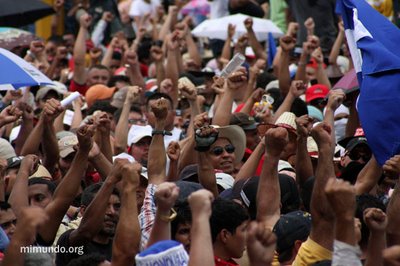WELCOME TO THE ARCHIVE (1994-2014) OF THE MAQUILA SOLIDARITY NETWORK. For current information on our ongoing work on the living wage, women's labour rights, freedom of association, corporate accountability and Bangladesh fire and safety, please visit our new website, launched in October, 2015: www.maquilasolidarity.org
December 15, 2009
Mounting evidence suggests that fraud was committed in the November 29 Honduran national elections, but the fraud wasn't against the minority who voted; it was against the majority who abstained.
The results of presidential election were never in doubt. Porfirio "Pepe" Lobo of the right wing National Party won handily over Elwin Santos of the Liberal Party. Both candidates had actively supported the June 28 military coup.
The real contest was between deposed president Manuel Zelaya and the National Resistance Front on the one side and the political and economic elite behind the coup on the other.

Zelaya and the Resistance, as well as approximately 100 presidential, congressional and mayoral candidates who withdrew from the electoral race, had called on registered voters to boycott the elections as a show of opposition to the coup. The traditional parties and the army, meanwhile, had labelled anyone who failed to vote as unpatriotic, and those promoting a boycott as traitors, communists and terrorists.
Repression against boycott promoters
In the final days of the campaign, repression against those promoting the boycott increased significantly.
On the day before the election, security forces ransacked the offices and training centre of COMAL, a Quaker-supported alternative marketing network for agricultural products.
The soldiers, who claimed they were looking for weapons and "subversive" materials, confiscated four computers, photos of COMAL members taking part in anti-coup protests, testimonies on human rights abuses under the coup, a list of employees and participants in COMAL training workshops, as well as the petty cash fund.
If election day itself was relatively peaceful it was because the Resistance was calling on its supporters to stay home to avoid violent confrontations with the military. However in San Pedro Sula, the centre of the maquila industry, where local members of the Resistance staged a large, peaceful demonstration against the coup, security forces responded by attacking protesters with water canons and batons and arresting 38 people, including two international human rights observers from the Latin American Council of Churches.
Voter turnout
On election night, the president of the Supreme Electoral Tribunal (TSE) proclaimed that 62% of all eligible voters had defied Zelaya's call for a boycott, thereby legitimizing the electoral process and the transfer of power to a newly elected government.
Yet the TSE's preliminary results were dramatically different from those of an election observer organization working with the TSE, Hagamos Democracia, which reported a 47.6% voter participation rate.
And they were completely at odds with the 65% voter abstention figure released by the National Resistance Front at a press conference the day after the vote where it announced the victory of its election boycott campaign.
Despite the wide discrepancies in projected voter participation rates, it is the 62% figure that has been quoted repeatedly by the international media. It was also used by the US and Canadian governments to justify their endorsement of the elections as an important step forward toward a return to constitutional order.
The reported massive voter turnout was also a major theme in the December 2 Honduran congressional debate where only 14 of 128 members of Congress dared to vote in favour of Zelaya's reinstatement, which would have allowed him to complete his term as head of a unity government.
Then two days later, on December 4, the TSE quietly released revised figures indicating that only 49% of eligible voters had actually gone to the polls.
More recently, the Real News Network released a video revealing that the TSE's original estimate of voter turnout was 49%, and the election night report was pure fantasy.
The video also includes face-to-face interviews with people working at one of the largest polling stations in San Pedro Sula, revealing that the average voter participation rate at that station was only 37%.
We may never know the truth about how many Hondurans stayed home on November 29 to protest the coup and/or because they have no faith in the electoral process. What we do know is that fewer than 50% of the population voted.
An ominous future
Contrary to the view expressed by the US and Canadian governments that the elections were any important step toward national reconciliation and a return to constitutional order, the coup supporters who triumphed in the election have shown no interest in reconciliation with president Zelaya or the members of the Resistance.
As international attentions shifts from the Honduras crisis to other hotspots around the globe, we can anticipate that political repression will increase rather than diminish.